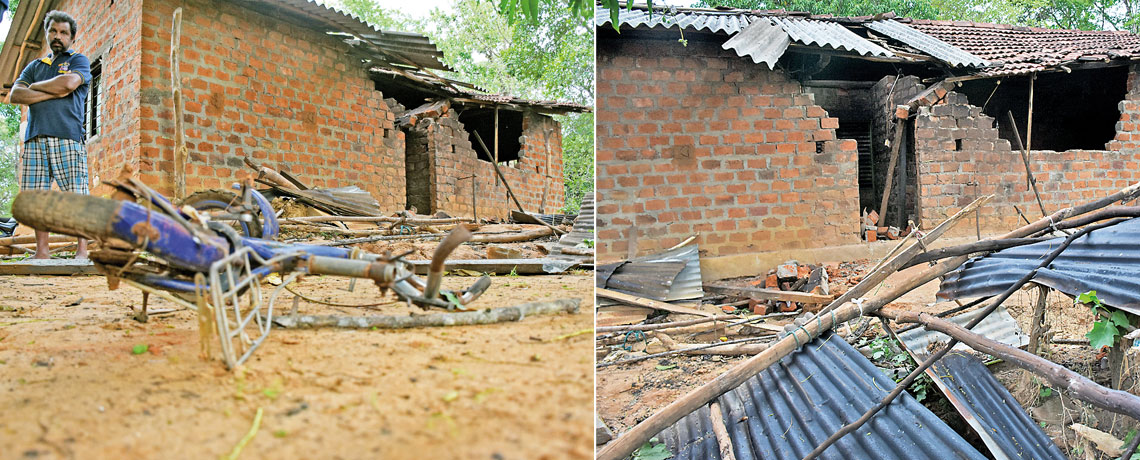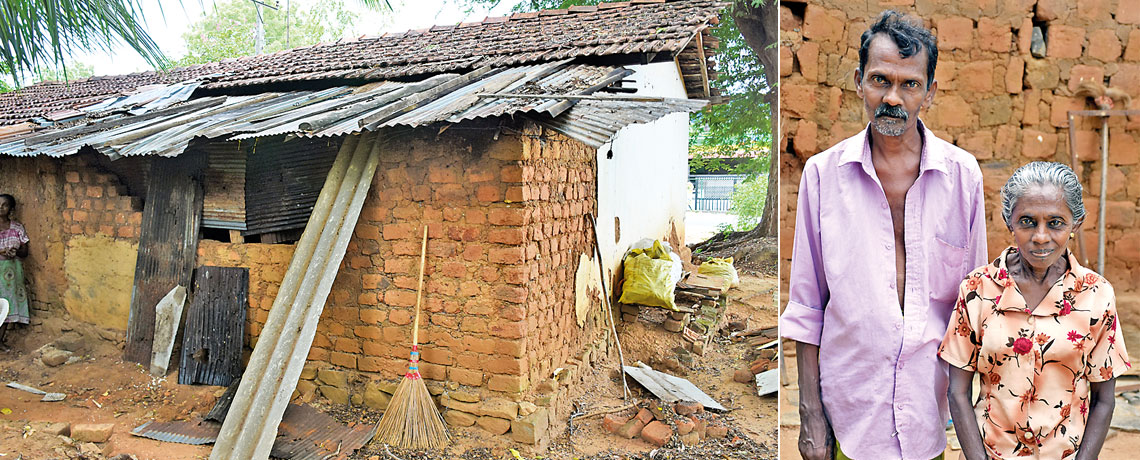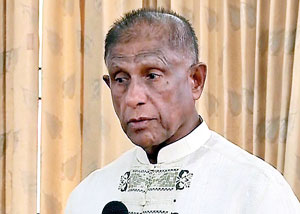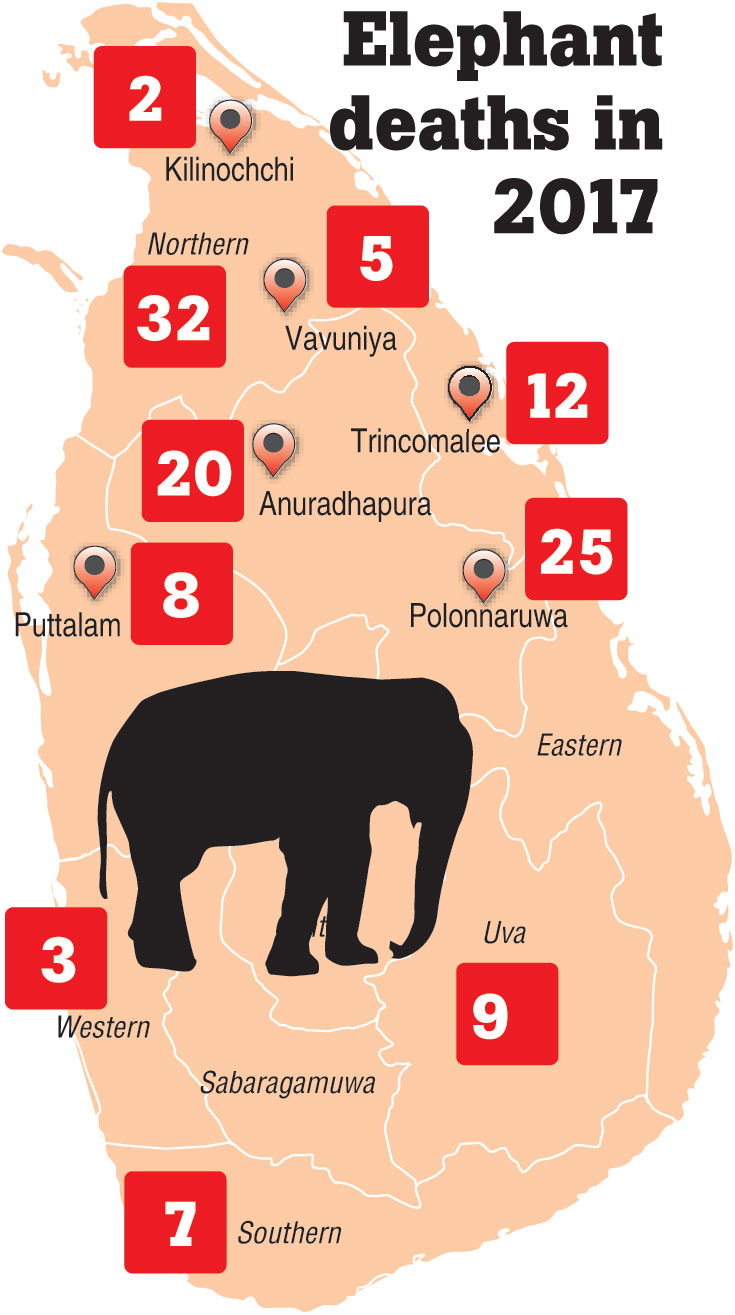06 Sep 2017 - {{hitsCtrl.values.hits}}

Habitat loss has resulted in elephants coming in to direct contact with humans. The animals, which were long revered in the country’s culture and religion, have now become a symbol of conflict over the past few years. Although wildlife enthusiasts have protested against human encroachment and have suggested possible ways of keeping away from these animals, humans seem to be doing the opposite. As a result, over 2000 elephants have perished in to the soil as a result of this conflict during the past 12 years. The conflict still exists in many parts of the country although many incidents aren’t reported.
Cries from conflict areas
 While on a recent visit to Mahiyangana, the Daily Mirror learned that several houses had been damaged as a result of this conflict during early August. Hence, with the help of our guide, Ajith, we then took off to visit the affected. While speaking to the victims the Daily Mirror learned that the electric fences in the area have been switched off and that they were the only solution to the problem.
While on a recent visit to Mahiyangana, the Daily Mirror learned that several houses had been damaged as a result of this conflict during early August. Hence, with the help of our guide, Ajith, we then took off to visit the affected. While speaking to the victims the Daily Mirror learned that the electric fences in the area have been switched off and that they were the only solution to the problem.
K.G Ranmanika’s house was severely damaged and the vegetable plots too were destroyed. She is currently residing at her daughter’s house situated a few blocks away from hers. “That night I heard a noise outside the house and when I went to see it was this elephant. I stayed indoors just to be safe and he did a lot of damage to the house. A little while later, the DWC officials visited my house and promised to give compensation and asked me to stay away from the house till they capture the elephant,”said Ranmanika.

R. M Karunasena is another victim of this human-elephant conflict. Karunasena said that it has been six years since the human-elephant conflict raised its head. “We have stopped working in our paddy fields and we don’t expect any yield from our vegetation because elephants now thrive on them. As a result we don’t have any food during the Yala or Maha seasons. Those days they used to come at night and now they come even during the day as well,” said Karunasena.
As we walked further in to this now-peaceful village setting in the heart of Mahiyangana, our guide Ajith showed more houses that had been destroyed by this ferocious elephant. We then stepped in to D. Kanthilatha’s house to observe the damages. She is a self-employed woman who earns a fair income to feed her family by making hoppers. “My son is sick and I have to take him to Colombo every month. For that I need approximately Rs. 3000 or more. A few days back this elephant destroyed our kitchen and now I have to fix those damages as well. I even wrote a letter to the DWC officials because they don’t compensate us on time. This is the first time that we were attacked by an elephant, but there have been instances when elephants loitered around the village quite often. We want them to pay us an adequate amount of money because a few thousand rupees won’t do any justice,”she said.
Karunarathne and his sister live in close proximity to Kanthilatha’s. The following day, after Kanthilatha’s house was damaged, the elephant had gone in search of more food and had stopped at Karunarathne’s residence and consumed a gunny bag full of paddy. “I was at home with my sister when we heard a noise outside. Then the neighbours shouted warning us to stay indoors that an elephant was trying to bring down the house. Luckily there wasn’t much damage except for the front door which had a few cracks. The Maduru Oya forest reserve lies in the boundary of this village. As a result many untamed elephants frequent our village. We urge the DWC officials to take this elephant away before it takes away an innocent life,”Karunarathne pleaded.
I was at home with my sister when we heard a noise outside. Then the neighbours shouted warning us to stay indoors that an elephant was trying to bring down the house. Luckily there wasn’t much damage
“We don’t have water and have to walk miles to collect one gallon and then we have an elephant adding to the burden,” said Wijerathne carrying a plastic can filled to the brim with water. The prevailing drought has affected over 1.3 million individuals including those in Mahiyangana. “There is no permanent solution to this human-elephant conflict. A few months ago there were electric fences, but they don’t work anymore. If the electric fences were switched on this issue would have been solved to a greater extent, but that doesn’t seem to be the case. So far the DWC officials haven’t visited us to inquire about the latest incidents, but we hope that they would take the necessary measures,”said Wijerathne.
‘Compensation given isn’t enough’ : Grama Niladhari for Orubandiwewa and Serana Divisions
“Wildlife officials offer compensation, but that isn’t enough,” said D. M. P Dissanayake, the Grama Niladhari for Orubandiwewa and Serana Divisions. “Elephants frequent in Divisions such as Abeypura, Gemunupura, Arawatta, Serana and Orubandiwewa where there are tanks. The officials offered compensation depending on the extent of the damage caused. Therefore some claim to be underpaid in most instances. Some have been promised two bags of cement, but that wouldn’t solve the problem. Even the electric fences have been switched off and the elephants trample them down and charge in to the villages,” Dissanayake said.
 ‘We are trying to promote coexistence rather than confrontation’ : Gamini Jayawickrama Perera
‘We are trying to promote coexistence rather than confrontation’ : Gamini Jayawickrama Perera
On this note we contacted the subject minister Gamini Jayawickrama Perera who said that the sum has been increased to Rs. 500,000. “During the Rajapakse regime it was only Rs. 100,000, but we increased the amount. The usual procedure is for the Grama Sevaka (GS) to send a letter to the office of the Ministry of Health. The letter in turn goes to the Divisional Secretariat (DS). This is then sent to the area DS and he pays the amount with his funds. But now this transaction has been made easier. So it’s up to the DS and the GS to provide funds for the victims. On the other hand we aren’t offering contracts to put up electric fences and it is a responsibility vested upon the people. So we provide residents with raw materials and they have to put up the fence. In the case of crop damage we have introduced an insurance scheme so that the affected can recover the damages. Hence we are trying to promote coexistence rather than confrontation with these elephants,”the minister said.

Statistics
Deputy Director (Elephant Conservation) at the Department of Wildlife Conservation (DWC) U.L Thaufeeq told the Daily Mirror that 129 elephants have been killed due to the prevailing human elephant conflict within this year. “In addition to that 44 people have been killed as well. So far we have offered compensation worth Rs. 500,000 to each victim whose house was damaged and to those families who have lost a member during an encounter. If a person is injured we offer Rs. 75,000 as compensation. So far we haven’t implemented any compensation scheme for crop damage, but if the cultivation has been insured then they will be paid accordingly,”explained Thaufeeq.
23 Dec 2024 5 minute ago
23 Dec 2024 14 minute ago
23 Dec 2024 14 minute ago
23 Dec 2024 2 hours ago
23 Dec 2024 2 hours ago